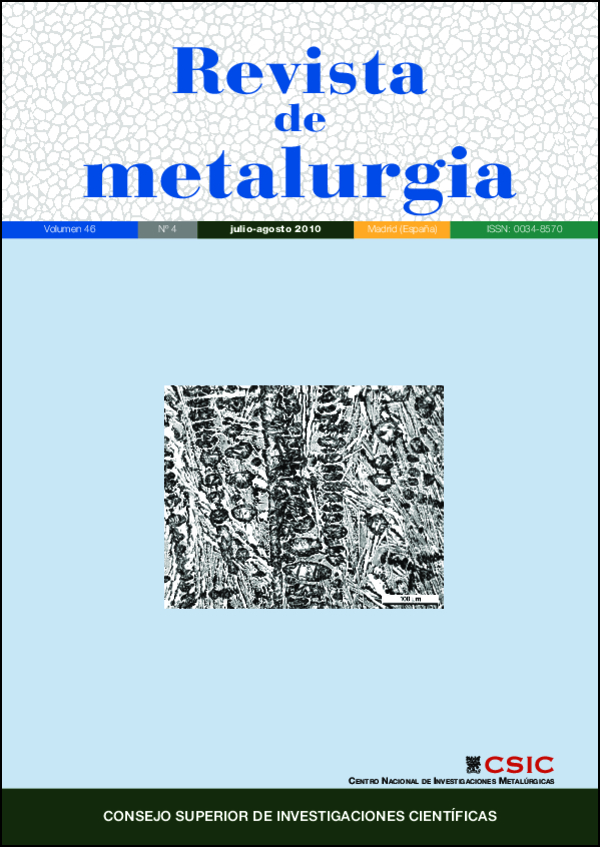Optimisation of the phosphate conversion treatment for generating protective coatings
DOI:
https://doi.org/10.3989/revmetalm.0959Keywords:
Phosphate, Corrosion, Protection, AdhesionAbstract
This paper evaluates the phosphate treatment as a chemical conversion treatment (CCT) free of chromium, from the basis of the study of a commercial treatment applied in phosphoric solution at different concentrations (100% and dilutions 1:2, 1:5 and 1:10). The optimum immersion time for the phosphate conversion treatment was established from the evolution over time of the open circuit potential. Protection against corrosion of the conversion layers was evaluated by polarisation resistance and electrochemical impedance measurements. The adhesion to the substrate was evaluated by pull-off tests. Results have shown that the application of an organic coating on the substrate with a previous phosphate treatment in 1:5 dilution (10 min.) increases the corrosion resistance in, at least, one order of magnitude with respect to the non phosphate-coated metal and improves the adhesion to the substrate, since the conversion layer obtained is part of the substrate and the surface generated increases the number and area of active sites.
Downloads
References
[1] G. Zhang, J. Huang, K. Yang y B.C. Zhang, Acta. Metall. Sin. 43 (2007) 1.186-1.192.
[2] B.Y. Jhonson, J. Edington y J. O’Keefe, Mater. Sci. Eng. 361 (2003) 225-231. doi:10.1016/S0921-5093(03)00516-1
[3] F.William, G. O’keefe, J. Mattew y Z. Haifen, Surf. Coat. Technol., 155 (2002) 127-136.
[4] B. Chico, J.C. Galván, D. de la Fuente y M. Morcillo, Prog. Org. Coat. 60 (2007) 45-53. doi:10.1016/j.porgcoat.2007.06.007
[5] A. Decroly y J. P. Petitjean, Surf. Coat. Technol. 194, (2005) 1-9. doi:10.1016/j.surfcoat.2004.05.012
[6] D. Chidambaram, C. Clayton y R. Halada, Electrochim. Acta 51 (15) (2006) 2.862-2.871.
[7] B.R.W. Hinton, J. Alloys. Comp. 180 (1992) 15-25.
[8] M.G.S. Ferreira, R.G. Duarte, M.F.Montemor y M.P. Simoes, Electrochim. Acta. 49 (2004) 2.927-2.935.
[9] B.R.W. Hinton y L. Wilson, Corros. Sci. 29 (1989) 967-975. doi:10.1016/0010-938X(89)90087-5
[10] C. Wang, F. Jiang y F. Wang, Corros. Sci. 46 (2004) 75-89. doi:10.1016/S0010-938X(03)00135-5
[11] L. Jacobi,Macchia O Ind.Mecánica, 17, (1935) 137-142.
[12] R. R. Tanner,Monthly, Rev. Am. Electroplaters Soc. (1934) 21-29.
[13] M. Thornton-Murray,M. Eng. 85 (1908) 870-882.
[14] T.W. Coslett, British Patent 8, 667, (1906).
[15] T.W. Coslett, British Patent 15, 628, (1908).
[16] T.W. Coslett, British Patent 22, 743, (1909).
[17] T.W. Coslett, British Patent 28, 131, (1909).
[18] L.E. Eckelmann, Chem.Metall. Eng. 21 (1919) 787-790.
[19] W.H. Allen, U.S. Patent 1, 206, 075, (1916).
[20] W.H. Allen, U.S. Patent 1, 311, 726, (1914).
[21] V.M. Darsey y R.R. Tanner, U.S. Patent 1, 887, 967, (1932).
[22] X. Llovensá, R.M. Raurell y S.A. Hodges, Paint Coat. Ind. Mag. (2010) 34-37.
[23] R. Naderi y M. M. Attar, J. Appl. Electrochem. (2009) 2.353-2.358.
[24] R. Naderi y M. M. Attar, Prog. Org. Coat. (2009) 314-320. doi:10.1016/j.porgcoat.2009.08.009
[25] F.J.J. Kellner, K. Schütze,C. Kreutz y S.Virtanen, Surf. Interface Anal. 41 (2009) 911-917. doi:10.1002/sia.3118
[26] Y. Hamlaoui, L. Tifouti y F. Pedraza, Corros. Sci. 51 (2009) 2.455-2.462.
[27] L. Fedrizzi, F. Deflorian, S. Rossi, L. Fambri y P.L. Bonora, Prog. Org. Coat. 42 (2001) 65-74. doi:10.1016/S0300-9440(01)00153-9
[28] T.S.N. Sankara, Rev. Adv.Mater. Sci. 9 (2005) 130-177.
[29] R.Moore y B. Dunham,Met. Finish. 106 (2008) 46-55. doi:10.1016/S0026-0576(08)80259-0
[30] C.G.Munger, Corrosion prevention by protective coatings, Ed. NACE, First edition, Houston, USA, 1984, pp. 87-96.
[31] R.M. Burns yW.W. Bradley, Protective Coatings for Metals, Ed. Reinhold Publishing Co., New York, USA, 1964, pp. 236-380.
[32] N.R. Roobol, Industrial painting principles and practices, Ed. Hanser Gardner Publications, Second edition, Munich, Germany, 1997, pp. 346-420.
[33] N. Bretherton, G. E. Thompson y S. Turgoose, Corros. Sci. 35 (1993) 1.297-1.303.
[34] E. Onofre-Bustamante, M.A. Domínguez- Crespo, J. Genescá-Llongueras, F.J. Rodríguez- Gomez, Surf. Coat. Technol., (2007) 4.666-4.676.
[35] D. B. Freeman, Phosphating and Metal Pretreatment - A Guide to Modern Processes and Practice, Ed. Industrial Press, First edition, New York, USA, 1986, pp. 123-180.
[36] W. Rausch, The Phosphating of Metals, Ed. Finishing Publications, London, England, 1990, pp. 96-123.
[37] C. G. Munger, Corrosion prevention by protective coatings, Ed. Nace, First edition Houston, USA, 1984, pp. 184-256.
[38] V.F. Cunha, G.F. Andrade, C.R. Araujo y T.Matencio, Appl. Surf. Sci. 253 (2006) 2.875-2.884.
[39] J. Genescá, Técnicas electroquímicas para el control y estudio de la corrosión, Ed. Universidad Nacional Autónoma de México, DF, México, 2002, pp. 45-70.
Downloads
Published
How to Cite
Issue
Section
License
Copyright (c) 2010 Consejo Superior de Investigaciones Científicas (CSIC)

This work is licensed under a Creative Commons Attribution 4.0 International License.
© CSIC. Manuscripts published in both the printed and online versions of this Journal are the property of Consejo Superior de Investigaciones Científicas, and quoting this source is a requirement for any partial or full reproduction.
All contents of this electronic edition, except where otherwise noted, are distributed under a “Creative Commons Attribution 4.0 International” (CC BY 4.0) License. You may read the basic information and the legal text of the license. The indication of the CC BY 4.0 License must be expressly stated in this way when necessary.
Self-archiving in repositories, personal webpages or similar, of any version other than the published by the Editor, is not allowed.
















